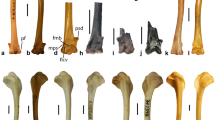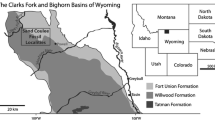Summary
The phylogenetic affinities between the shoebill (Balaenicipitidae) and pelecaniform and ciconiiform birds are analysed. A cladistic analysis of 54 anatomical characters resulted in monophyly of the taxon (Scopidae + (Balaenicipitidae + Steganopodes (sensu Cracraft 1985))) and showed both Ciconiiformes and Pelecaniformes to be polyphyletic. Derived characters which support the resulting phylogeny are discussed. Monophyly of the taxon (Scopidae + (Balaenicipitidae + Steganopodes)) is better supported by morphological evidence than monophyly of the taxon (Procellariiformes + (Phaethontidae + Steganopodes)) which was established by Cracraft (1985). The shared derived characters of Scopidae, Balaenicipitidae and Steganopodes are furthermore less easily explained by convergent evolution than by the few characters which support monophyly of the taxon (Phaethontidae + Steganopodes). The Phaethontidae share derived characters with the Procellariiformes, which might support a sister group relationship between the two taxa.
Zusammenfassung
Die phylogenetischen Beziehungen zwischen dem Schuhschnabel (Balaenicipitidae) und pelecaniformen und ciconiiformen Vögeln werden untersucht. Eine kladistische Analyse von 54 anatomischen Merkmalen resultierte in Monophylie des Taxons (Scopidae + (Balaenicipitidae + Steganopodes (sensu Cracraft 1985))) und ergab, dass sowohl Ciconiiformes als auch Pelecaniformes polyphyletisch sind. Abgeleitete Merkmale, welche den resultierenden Stammbaum begründen, werden diskutiert. Monophylie des Taxons (Scopidae + (Balaenicipitidae + Steganopodes)) ist besser gestützt durch morphologische Merkmale, als die von Cracraft (1985) begründete Monophylie des Taxons (Procellariiformes + (Phaethontidae + Steganopodes)). Die gemeinsamen abgeleiteten Merkmale von Scopidae, Balaenicipitidae und Steganopodes lassen sich darüber hinaus weniger leicht durch Konvergenz erklären, als die wenigen Merkmale, welche Monophylie des Taxons (Phaethontidae + Steganopodes) begründen könnten. Die Phaethontidae teilen abgeleitete Merkmale mit den Procellariiformes, welche eine Schwestergruppenbeziehung zwischen beiden Taxa stützen könnten.
Similar content being viewed by others
References
Bartlett, A. D. (1861): On the affinities ofBalaeniceps. Proc. Zool. Soc. London 1861: 131–134.
Baumel, J.J. & Witmer, L.M. (1993): Osteologia. In: Baumel, J.J., King, A. S., Breazile, J.E., Evans, H. E. & Vanden Berge, J. C. (Eds.): Handbook of avian anatomy: Nomina Anatomica Avium. Publications of the Nuttall Ornithological Club 23:45–132.
Beddard, F. E. (1884): A contribution to the anatomy ofScopus umbretta. Proc. Zool. Soc. London 1884:543–553.
Beddard, F.E. (1888): On certain points in the Visceral Anatomy ofBalaeniceps rex bearing on its Affinities. Proc. Zool. Soc. London 1888: 284–290.
Beddard, F.E. (1898): The structure and classification of birds. London.
Bock, W.J. (1960): Secondary articulation of the avian mandible. Auk 77: 19–55.
Böhm, M. (1930): Über den Bau des jugendlichen Schädels vonBalaeniceps rex nebst Bemerkungen über dessen systematische Stellung und über das Gaumenskelett der Vögel. Z. Morph. Ökol. Tiere 17: 677–718.
Cottam, P. A. (1957): The pelecaniform characters of the skeleton of the Shoebill Stork,Balaeniceps rex. Bull. Brit. Mus. (Nat. Hist.) Zool. 5: 51–72.
Cracraft, J. (1968): The Lacrimal-Ectethmoid Bone Complex in Birds: A Single Character Analysis. The American Midland Naturalist 80: 316–359.
Cracraft, J. (1981): Toward a phylogenetic classification of the recent birds of the world (Class Aves). Auk 98: 681–714.
Cracraft, J. (1985): Monophyly and phylogenetic relationships of the Pelecaniformes: a numerical cladistic analysis. Auk 102: 834–853.
Cracraft, J. (1988): The major clades of birds. In: Benton, M. J. (Ed.): The Phytogeny and Classification of the Tetrapods, Volume 1: Amphibians, Reptiles, Birds: 339–361. Oxford.
del Hoyo, J., Elliott, A. & Sargatal, J. (1992, Eds.): Handbook of the Birds of the World, vol. 1. Barcelona.
Elliott, A. (1992): Family Balaenicipitidae (Shoebill). In: del Hoyo, J., Elliott, A. & Sargatal, J. (Eds.): Handbook of the Birds of the World, vol. 1:466–471, Barcelona.
Farris, J. S., Källersjö, M., Crowe, T. M., Lipscomb, D. & Johansson, U. (1999): Frigatebirds, Tropicbirds and Ciconiidae. Excess of Confidence Probability. Cladistics 15: 1–7.
Feduccia, A. (1977): The whalebill is a stork. Nature 266:719–720.
Forbes, W. A. (1882): Report on the Anatomy of the Petrels (Tubinares), collected during the Voyage of H. M. S. Challenger. Report on the scientific results of the voyage of H. M. S. Challenger during the years 1873–76, zoology, vol. 4: 1–64.
Gadow, H. (1891): Vogel. I. — Anatomischer Theil. In: Bronn, H. G. (Ed.): Klassen und Ordnungen des Thier-Reichs, vol. 6 (4). Leipzig.
Gadow, H. (1893): Vogel. II. — Systematischer Theil. In: Bronn, H. G. (Ed.): Klassen und Ordnungen des Thier-Reichs, vol. 6 (4). Leipzig.
George, J. C. & Berger, A. J. (1966): Avian myology. New York.
Giebel, C.G. (1873):Balaeniceps rex. Z. ges. Naturw. Berlin 41: 350–354.
Gould, J. (1852): On a new and most remarkable form in ornithology. Proc. Zool. Soc. London 1851: 1–2.
Groth, J.G. & Barrowclough, G.F. (1999): Basal Divergences in Birds and the Phylogenetic Utility of the Nuclear RAG-1 Gene. Molecular Phylogenetics and Evolution 12: 115–123.
Harrison, C. J.O. & Walker, A. (1982): Fossil Birds from the Upper Miocene of Northern Pakistan. Tertiary Res. 4: 53–69.
Harshman, J. (1994): Reweaving the tapestry: What can we learn from Sibley and Ahlquist (1990)? Auk 111: 377–388.
Hedges, S.B. & Sibley, C.G. (1994): Molecules vs. morphology in avian evolution: The case of the “pelecaniform” birds. Proc. Natl. Acad. Sci. U.S.A. 91: 9861–9865.
Houde, P. (1987): Critical evaluation of DNA hybridization studies in avian systematics. Auk 104: 17–32.
Lanham, U. N. (1947): Notes on the phylogeny of the Pelecaniformes. Auk 64: 65–70.
Lanyon, S.M. (1992): Review of Sibley and Ahlquist’s“Phylogeny and Classification of Birds. A Study in Molecular Evolution”. Condor 94: 304–310.
Livezey, B.C. & Zusi, R.L. (2001): Higher-order phylogenetics of modern Aves based on comparative anatomy. Netherlands Journal of Zoology 51: 179–205.
McKitrick, M. C. (1991): Phylogenetic Analysis of Avian Hindlimb Musculature. Univ. Michigan Mus. Zool. Misc. Publ. 179: 1–85.
Mikhailov, K. E. (1995): Eggshell structure in the Shoebill and pelecaniform birds: comparison with Hamerkop, herons, ibises and storks. Canadian Journal of Zoology 73 (9): 1754–1770.
Mitchell, P. C. (1913): Observations on the Anatomy of the Shoe-bill (Balaeniceps rex) and allied birds. Proc. Zool. Soc. London 1913: 644–703.
Olson, S.L. (1977): A Lower Eocene frigatebird from the Green River Formation of Wyoming (Pelecaniformes: Fregatidae). Smithson. Contrib. Paleobiol. 35: 1–33.
Olson, S.L. (1979): Multiple origin of the Ciconiiformes. Proc. Colonial Waterbird Group 1978: 165–170.
Olson, S. L. (1982): A critique of Cracraft’s classification of birds. Auk 99: 733–739.
Olson, S. L. (1984): A hamerkop from the early Pliocene of South Africa (Aves: Scopidae). Proc. Biol. Soc. Wash. 97: 736–740.
Orta, J. (1992): Family Fregatidae (Frigatebirds). In: del Hoyo, J., Elliott, A. & Sargatal, J. (Eds.): Handbook of the Birds of the World, vol. 1: 362–374, Barcelona.
Parker, W.K. (1861): On the osteology ofBalaeniceps rex. Trans. Zool. Soc. London 4: 269–352.
Payne, R.B. & Risley, C. J. (1976): Systematics and Evolutionary Relationships Among the Herons (Ardeidae). Univ. Michigan Mus. Zool. Misc. Publ. 150: 1–115.
Rasmussen, D.T, Olson, S.L. & Simons, E.L. (1987): Fossil Birds from the Oligocene Jebel Qatrani Formation, Fayum Province, Egypt. Smithsonian Contributions to Paleobiology 62: 1–20.
Rea, A. (1983): Cathartid affinities: A brief overview. In: Wilbur, S.R. & Jackson, J.A. (Eds.): Vulture biology and management: 26–56. Berkeley.
Reinhardt, J. (1861): Some Remarks on the GenusBalaeniceps. Ibis 1862: 158–175.
Saiff, E.I. (1978): The middle ear of the skull of birds: The Pelecaniformes and Ciconiiformes. Zoological Journal of the Linnean Society 63: 315–370.
Sibley, C.G. & Ahlquist, J.E. (1990): Phylogeny and classification of birds: A study in molecular evolution. New Haven and London.
Siegel-Causey, D. (1990): Phylogenetic patterns of size and shape of the nasal gland depression in Phalacrocoracidae. Auk 107: 110–118.
Siegel-Causey, D. (1997): Phylogeny of the Pelecaniformes: Molecular Systematics of a Privative Group. In: Mindell, D. P. (Ed.): Avian Molecular Evolution and Systematics: 159–171. San Diego.
Stegmann, B. (1963): Der Processus internus indicis im Skelett des Vogelflugels. J. Ornithol. 104: 413–423.
Swofford, D.L. (1993): PAUP: Phylogenetic analysis using parsimony, version 3.1. Champaign.
Technau, G. (1936): Die Nasendrüse der Vögel. Zugleich ein Beitrag zur Morphologie der Nasenhohle. J. Ornithol. 84: 511–617.
Vanden Berge, J. C. (1970): A Comparative Study of the Appendicular Musculature of the Order Ciconiiformes. American Midland Naturalist 84: 289–364.
Vanden Berge, J. C. & Zweers, G. A. (1993): Myologia. In: Baumel, J. J., King, A. S., Breazile, J.E., Evans, H. E. & Vanden Berge, J. C. (Eds.): Handbook of avian anatomy: Nomina Anatomica Avium. Publications of the Nuttall Ornithological Club 23: 189–247.
van Tets, G. F. (1965): A comparative study of some social communication patterns in the Pelecaniformes. Ornithol. Monogr. 2: 1–88.
van Tuinen, M., Butvill, D.B., Kirsch, J.A.W. & Hedges, S.B. (2001): Convergence and divergence in the evolution of aquatic birds. Proc. R. Soc. Lond. B 268: 1345–1350.
Walters, M. (1994): Birds’ eggs. London.
Warheit, K.I., Good, D.A., de Queiroz, K. (1989): Variation in numbers of scleral ossicles and their phylogenetic transformations within Pelecaniformes. Auk 106: 383–388.
Author information
Authors and Affiliations
Rights and permissions
About this article
Cite this article
Mayr, G. The phylogenetic affinities of the Shoebill (Balaeniceps rex). J Ornithol 144, 157–175 (2003). https://doi.org/10.1007/BF02465644
Accepted:
Published:
Issue Date:
DOI: https://doi.org/10.1007/BF02465644




